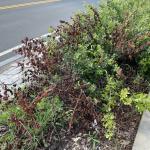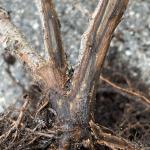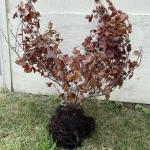Fusarium Wilt of Fragrant Sumac
Pathogen and Host
The fungal pathogen Fusarium oxysporum is responsible for Fusarium wilt of fragrant sumac (Rhus aromatica). The disease was first reported from Kansas in 1994 (O’Mara and Tisserat 1997) and samples submitted to the UMass Plant Diagnostic Laboratory have originated from Massachusetts and New Hampshire. Fragrant sumac is native throughout most of the eastern United States and Canada and is increasingly popular as an ornamental. Mass plantings of R. aromatica ‘Gro-Low’ help to stabilize slopes and can thrive in difficult roadside sites. Their flowers also attract an abundance of pollinators and the red autumn foliage is very attractive. The disease appears to be uncommon across the region, but given the rising popularity of fragrant sumac it may increase in incidence.
Symptoms
Fusarium wilt is a soilborne disease that affects the xylem, resulting in water starvation. Symptoms of the disease include browning leaves, canopy dieback and outright death of infected plants. A dark-colored stain of the vascular tissue can be observed when the bark is removed from infected plants. The bark may also be soaked with sticky sap produced by the plant. The fungus produces a thick-walled resting structure (chlamydospore) that can survive in the soil. Therefore, once established the pathogen will persist at a site and fragrant sumac should not be replanted if the disease is confirmed. Strains of F. oxysporum responsible for vascular wilts are host-specialized and the population that attacks R. aromatica will not infect plants outside of genus Rhus (or family Anacardiaceae). As such, other woody plants used as replacement will be unaffected by the pathogen. Fusarium oxysporum may spread within infected nursery stock or contaminated soils. Additionally, spores may be transported via wind, rain and insects, along with unconventional vectors.
Management
Remove infected plants and discard them off site away from other fragrant sumac. Ensure fragrant sumac nursery stock is free of the disease prior to planting. Because F. oxysporum is soilborne and vascular wilts are systemic within infected plants, fungicide application is likely to have little to no effect on the disease. Regularly scout plantings of fragrant sumac for symptoms of the disease and immediately remove plants with confirmed cases.
Reference
O’Mara, J. and Tisserat, N. 1997. A vascular wilt of fragrant sumac caused by Fusarium oxysporum. Plant Disease 81(11): 1333.


